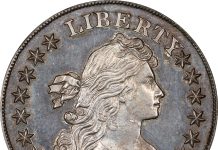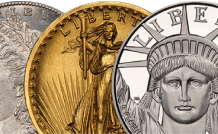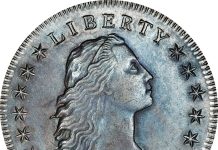An Exceptional Half-Dozen Early Dimes
By Barry Sunshine
As a certified public accountant and a sophisticated collector of the finest-quality early dimes, I know how to count to six with the best dimes I have ever seen or owned. I’ve been a numismatist for over 40 years and one of my favorite series is early U.S. dimes. There are many reasons why I enjoy collecting this series and they include holding early U.S. American history; researching different die varieties for each year; owning dimes that are pedigreed to early famous collectors; owning coins that have very cool stories to tell, including their rarity; and owning early dimes that are originally toned attractive examples.
Finding originally toned attractive examples for each year takes a lot of patience and money. As an assemblage of coins grows to completion, collectors are proud of their accomplishments. Some collectors participate and compete with other collectors in registry sets and try to achieve having the highest-graded sets. Also, the camaraderie that collectors develop with each other deepens the friendship. I have had close collector friends for well over 20 years.
These are my six favorite dimes:
1796 Draped Bust dime. The first year of the regular-issue dimes was 1796. It was the first year that had a Small Eagle reverse design. This Small Eagle reverse was used on dimes in 1796 and 1797. All 1796 dimes were minted in Philadelphia and because 1796 was the first year that the U.S. Mint manufactured dimes, collectors saved coins in quantity during that year of issue because the coins seemed new, novel and interesting. These coins are frequently found in high grades, but demand for them is strong because demand for that first-year type is feverish.
The 1796 example in my personal collection is graded by the Professional Coin Grading Service (PCGS) as About Uncirculated-58 on the one through 70 scale, where one is the lowest and 70 is perfect. 60 through 70 are the Mint State or Uncirculated grades.
When you hold this 1796 dime, you are truly holding early U.S. history in your hands. My nearly Uncirculated coin has the slightest friction on its highest points from being very slightly circulated or spent and its gorgeous toning gives it very high eye appeal. Adding to the desirability of this coin is that is resides in an old PCGS holder along with it having a green holographic sticker from CAC, a sort of Good Housekeeping seal of approval from the Certified Acceptance Corporation. A coin in an older grading-service holder gives reassurance of the stability of the surfaces of the coin.
CAC is now a world-class, full-service certification company. But from its inception, it applied green stickers to holders of PCGS and NGC (Numismatic Guaranty Corporation) certified coins that met its standard for solid or high-end for the grade. CAC was founded in 2008 by John Albanese, whom I call “the wizard.” The wizard also founded NGC and was a founder of PCGS.
I’m so happy for my son, David Sunshine, a professional coin dealer, who received wizard John Albanese’s endorsement in the 2025 COINage Book of Lists as one of the “World’s Leading Coin Graders.”
1814 Capped Bust dime with “StatesOfAmerica” variety. The 1814 Capped Bust dime was minted using different dies by the U.S. Mint. There are two basic varieties of 1814 dimes: large and small dates.
There is a subset variety of the large date example that has an engraving error where the words “States of America” are too close together, making three words look like one word. This variety is the scarcest of all the 1814 dimes and it is highly sought after by collectors. Uncirculated examples, when sold, carry significant premiums.
My example of the 1814 StatesOfAmerica example has a fascinating story to tell. The coin was found in a safe on board the Steamship Central America that sank in 1857. The coin resided on the ocean floor for over 150 years. This dime displays significant wear from its 43 years of being spent or passed from hand to hand prior to being recovered. This dime, with its die variety and story to tell, is particularly desirable.
1807 Draped Bust dime. The last year of issue of the Draped Bust dime design was 1807. Dimes minted between 1798 through 1807 have a Large Eagle reverse design that is referred to as the Heraldic reverse. This dime is the same size as the U.S. Quarter Eagle gold coin, and an interesting fact is that the U.S. Mint used the same reverse dies to mint the Quarter Eagles as it did to manufacture the 1807 dime. Coin dies took many hours to engrave, so the U.S. Mint used these dies until they wore out. This 1807 dime is a very attractively toned example that has been graded by PCGS as Mint State 63.
1821 Capped Bust dime. The Capped Bust dimes from 1809 to 1828 are referred to as a large size because they were minted using the screw press with an open collar. The screw press struck coins with inconsistent pressure. Therefore, well-struck coins during this time are quite rare. This 1821 dime is extremely well struck and it has magnificent toning. The coin has a wonderful pedigree as it’s from the D. Brent Pogue collection that was sold by Stack’s Bowers Galleries. Pogue assembled one of the greatest early U.S. coin collections. Prior to Pogue owning the coin it was owned by James A. Stack. The coin is very high on eye appeal.
1829 JR-1 Capped Bust dime with Curl Base 2. The Capped Bust dimes from 1828 to 1837 are referred to as a reduced size because they were minted using the steam press. The steam press was able to apply a more consistent pressure so that these dimes were well struck or manufactured with the detail intended by the designer.
In 1829, the Mint made dimes with 12 different die marriages. Dimes from 1829 are full of interesting die marriage varieties, even though the mintage is less than a million. The major varieties consist of Flat Base and Curl Base “2” in the date as well as Small, Medium, Large, Extra Large and Small over Large denomination 10 on the reverse.
Many collectors try to assemble a full set of the different die marriages and, although challenging, can be done with patience and persistence. The example that I own is the Curl Base 2, the only die marriage that has a Curl Base 2 in the date. This is the rarest die marriage and only 50 are extant. These known examples are mostly in low grades and include damaged coins. My specimen was formerly part of the David Davis collection. Davis was a co-author of the 1984 reference, Early United States Dimes, 1796-1837: A Reference Book of Their Types, Varieties, and Rarity.
Honorable mention, and not pictured, is the 1829 Capped Bust dime with Extra Large 10. This Capped Bust dime is an interesting variety because the denomination on the reverse exhibits repunching in its early die state. This is a very tough die marriage that is considered a rarity 4+ with 75 to 125 that are known to exist.
Most Early dime collectors don’t have this coin in their sets. The few that do own examples in lower grade levels. Grades from Extremely Fine to Mint State are very rare.
A few years ago, the finest certified was a Mint State 63. However, a Mint State Gem 66 was later graded. This Gem is three grades higher than the next highest grade. Alan Lovejoy, a past collector, put together one of the finest sets of Capped Bust dimes and his 1829 JR-1 was only a Mint State 63. This 1829 JR-1 became an immediate favorite as a result of its rarity and beauty.
1804 Draped Bust dime with 14 Stars variety. In 1804, the U.S. Mint produced only 8,265 dimes, which is the lowest mintage of any one year for Draped and Capped Bust dimes, so most would consider this date an absolute rarity.
There are two varieties for 1804: 13 and 14 stars. Draped Bust dime collectors consider this date as the key date and it’s highly desired by collectors. The 14-star variety is slightly scarcer than the 13-star variety, and I estimate that fewer than 100 known examples exist of both varieties.
I enjoy collecting early dimes because of their history, beauty, rarity and the stories behind the coins that intrigue me the most. It’s fascinating to recount the stories that coins can tell and wonderful that I have been able to develop so many friendships that came about from collecting coins.












